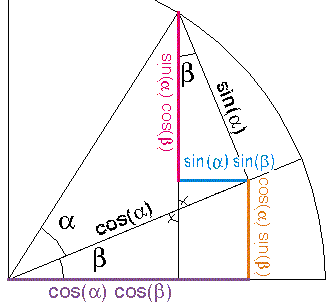 |  |
|
First two frames use definition of cos and sin (circle is unit circle) 3rd frame: opposite angles are equal, Angles of a triangle add up to 180 therefore top angle of upper right triangle is Beta 4th frame: Erect a perpendicular off of sin(alpha) line - this makes a small right triangle whose right most angle is Beta (because this angle added to the angle opposite beta = 90.
| cos(a+b) = cos(a) cos(b) - sin(a) sin(b)
and sin(a+b) = sin(a) cos(b) + sin (b) cos(a) |





